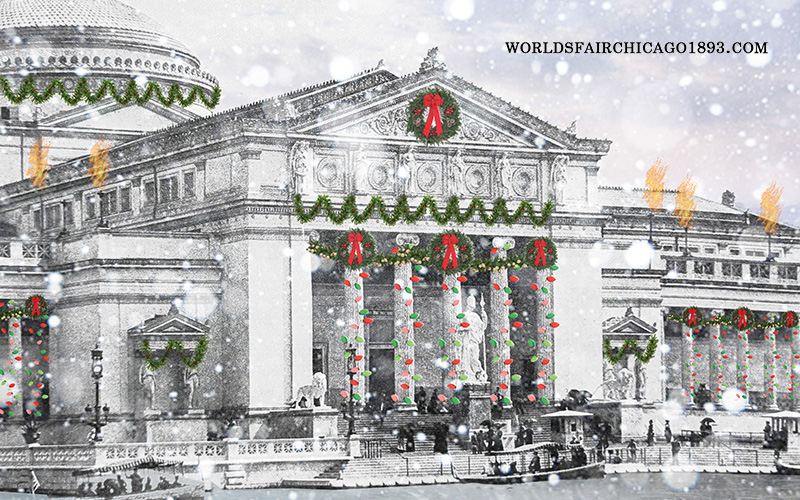
More than a dozen works of art depicting Christmas themes adorned the halls of the Palace of Fine Arts at the 1893 World’s Columbian Exposition.
Edwin H. Blashfield’s oil painting Christmas Bells (1891). [Image from Hitchcock, Ripley The Art of the World Illustrated in the Paintings, Statuary, and Architecture of the World’s Columbian Exposition. D. Appleton, 1895.]
Art critic Ripley Hitchcock described Christmas Bells as
“… a serious imaginative work, and one, too, which is characterized by vigor as well as grace and a splendid sense of power and movement. The architectural details of the picture—the heavy stone walls, with their grotesque gargoyles, the massive wooden beams strapped with steel to which the bells are attached—throw into relief the beautiful figures of the angels.” [Hitchcock 169]
.
Julian Hawthorne shared his mixed impression, writing:
“There is a joyful ringing of Christmas chimes, with a flight of Angels’ ding-donging them in the belfry. It is a fine conception, tolerably executed; but the first glance gives more pleasure than the subsequent ones. It is not a thoroughly well painted picture. But hearty angelic fun is a good thing to think about. And yet I am inclined to agree with Hildegarde, who said she thought that the human element in Christmas was the more touching and beautiful, and that has been missed here.” [Hawthorne 116]
.
The painting had the distinction of being exhibited at the Paris Salon of 1892 and today is held in the collection of the Brooklyn Museum. Born on Christmas day in 1848, Edwin Blashfield (1848–1936) painted a mural titled Metallic Arts inside the dome of the west entrance of the Manufactures and Liberal Arts Building, which Hitchcock described as “a distinguished feature of the art of the Exposition.” [Hitchcock 169]
J. Alden Weir’s The Christmas Tree (1890). [Image from the Terra Foundation for American Art.]
Charles Stanley Reinhart (1844–1896) of New York, who painted the south dome of the west entrance to the Liberal Arts building, was a third Exposition muralist to contribute some Christmas spirit to the fair. Reinhart’s pencil drawing Christmas Morning was displayed in the passage between the east and south courts of the second floor of the Art Palace.
Other Christmas art exhibited by American artists included Christmas Morning in Colonial Times by James S. King (1852–1925) of Upper Montclair, New Jersey, in the “engravings, etchings, prints” section; Christmas Presents at the Breakfast Table, a black and white drawing by Frank O. Small of Boston; Christmas Shopping, a black and white drawing by W. T. Smedley of New York; Bringing Home the Christmas Tree, a wood engraving by Walter M. Aikman; A Christmas Fantasy, a wood engraving by Frances S. King of Roseville, New Jersey, and A Christmas Vigil and Christmas Chimes, wood engravings by Frank French of East Orange, New Jersey.
In the German section were two Christmas works by Frank von Uhde (1848–1911). His larger canvas The Announcement to the Shepherds (also called The Angels Appearing to the Shepherds) hung on the south wall of Gallery 33, while his smaller oil painting Christmas Evening hung on the south wall of Gallery 28. “Of the figure painters, Fritz Uhde is acknowledged to be the best in the world at the present time,” writes Columbian Exposition historian William E. Cameron. “His studio in Munich has wielded a strong and lasting impression on modern art.” [Cameron 288]
Fritz von Uhde’s Christmas Evening. [Image from Modern Art Creations (Rand McNally, 1894).]
In Gallery 76 of the Italy Section, Ernesto Biondi (1855–1917) of Rome exhibited his sculpture Christmas Eve, one of thirteen of his works displayed at the Chicago fair. Danish painter Viggo Johansen (1851–1935) exhibited his oil painting Christmas Eve in Gallery 73 of the Denmark section. Christmas paintings from New South Wales shown in Australia House included Mrs. Williamson’s oil painting Christmas Bush and Alferd Sharp’s watercolor The Christmas Tree of New Zealand in Bloom.
Although the 1893 World’s Columbian Exposition closed several weeks before Yuletide, these artistic ornaments of the Christmas holiday decorated the Art Palace throughout the Fair.
SOURCES
Cameron, William E. The World’s Fair Being a Pictorial History of the Columbian Exposition. P.D. Farrell, 1893.
Hawthorne, Julian. Humors of the Fair. E.A. Weeks, 1893.
Hitchcock, Ripley The Art of the World Illustrated in the Paintings, Statuary, and Architecture of the World’s Columbian Exposition. D. Appleton, 1895.
Handy, Moses P. Revised Catalogue, Department of Fine Arts (Conkey, 1893).
Van Dyke, John C. “Retrospective Exhibition of the Society of American Artists” Harper’s Weekly, December 1892, pp. 1211–14.
